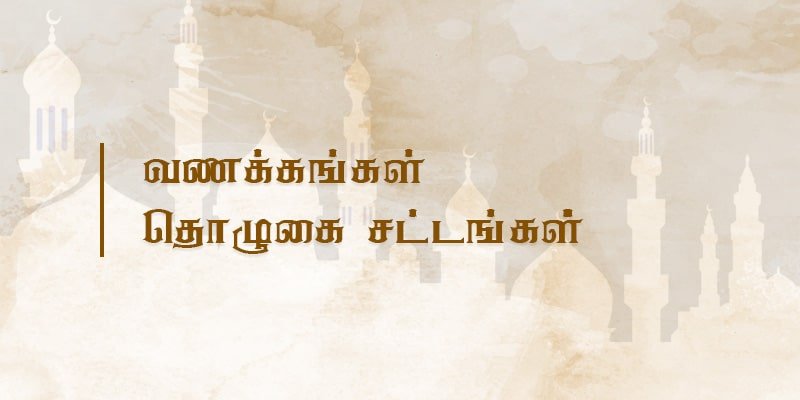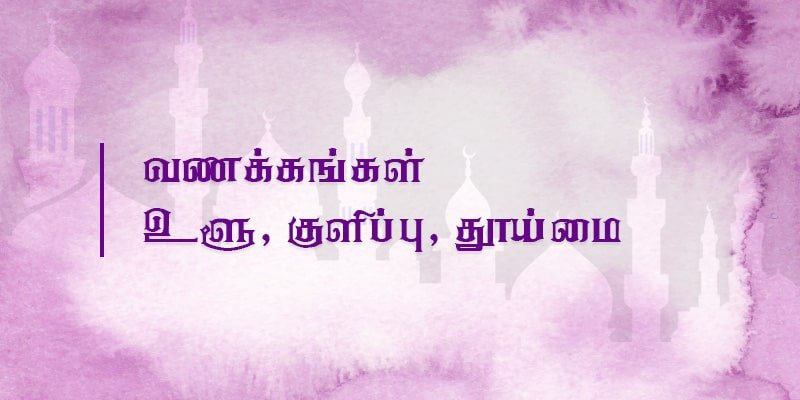378. The reason Prophet Muhammad married more than one woman.
In verse 33:50 of the Quran we find Prophet Muhammad being allowed to marry as may women as desired by him. And this is a special privilege granted to him alone.
Though there are numerous evidences in the Quran to prove Quran is God’s word and Prophet Muhammad is the messenger of God, the only matter that keeps nagging non-Muslims is the many marriages of the prophet. They critcize this aspect in the life of Prophet Muhammad by saying he a made a law for himself to conveniently live with many women.
The argument, that Prophet Muhammad created laws to make a convenient life for himself is entirely misconceived, because there are many laws specific to Prophet Muhammad that cause more inconveniences to him.
* When a law was promulgated that all can claim benefits from the Zakat fund collection in the government treasury. He made it forbidden for himself.
* He also made it forbidden for his heirs to claim benefits from the same fund.
* And he also brought in a law prohibiting his legal heirs to claim his belongings after his demise.
* Another law that was brought in by him was the restriction on accepting charity by him or his descendants at all times.
* Though others were required to maintain the mandatory duty of worshipping five times a day, he made it a must for himself to worship six times.
* He prohibited others from fasting some days for twenty-four hours, he burdened himself by doing the same.
In many matters the special laws that were exclusively for Prophet Muhammad caused more inconveniences than benefits to him. Moreover, some of the verses of the Quran that reprimanded him that affected his dignity were made known to everyone.
(We have extensively discussed this subject under the heading ‘This is God’s word’ in our preface and under the sub-heading ‘No expectation’ and also in our explanation point 168.) There is no justification in the criticism of Prophet Muhammad as a person who made laws to suit himself after going through the facts about the special privileges and laws.
He tells people even when reprimanded by the Almighty. And also tells people on God’s commandment about no-restrictions for him regarding the number of women he could get married to.
And he was the emperor of the world's largest kingdom during the last five years of his life. Those were the days when nobody could dare question the rulers, who lived with one or two wives legally and had several women illegally in the harems. Had Prophet Muhammad followed suit no one would have dared questioned it. He did not behave in such a manner, on the contrary he declared openly about his marriages. And moreover, he got married to women who would not be preferred by lusty men.
After having learnt all these facts no person would find fault with the many marriages of Prophet Muhammad.
We can assert the fact that Prophet Muhammad did not get married to many women due to lust, because he lived in his native place right from his birth till, he was declared himself as the messenger of God. The possibilities of a person leading an impeccable life till the age of forty is less. But when Prophet Muhammad declared his prophethood he placed his impeccability of his earlier life.
He proved his implacability by asking his people whether they have witnessed him talking even any mean words in the many years he lived with them.
(We have explained this verse 10:16 in the explanation point 212.)
His people could not challenge him (Prophet Muhammad) because he led a virtuous life and they have witnessed it.
The people who did not accept his ideology did so because they found it different from what they were following, and not because of his integrity or morality.
It could be understood that a person who lived an impeccable life in the heydays of youth could ever marry many women because of lust.
We need to bring this to our mind while analyzing the youthful days of Prophet Muhammad.
Prophet Muhammad got married the first when he was twenty-five years old. The life he led before he was twenty-five years old was a wonder. He did not dare raise his head to gaze at an alien woman. His life was so perfect that he never joined youth of his age to even pass comments on women. Those were the days when a woman was considered an object of pleasure with pride by men. His life was the only exception in those dark ages. He placed his forty years of past life in front of people when he declared himself as the messenger of God.
No one can throw a challenge to others with regards to one’s past life, because no one’s past can be that perfect. Even while assessing saints it has been said not to delve into their past and take into consideration their present disposition.
Only Prophet Muhammad had the courage to lay down his past in public for scrutiny.
The accusation that he got married to many women because of lust is baseless, because he lived an immaculate life till he declared himself as the messenger of God.
He was never accused of any allegation regarding his behaviour towards womenfolk He led a life in which even his enemies could not find a flaw.
It is normal for any uncared children to turn to be foolhardy adults, though Prophet Muhammad had all the chances of being misled by the society of those days, instead he lived a perfect life, belying the accusation he was a lusty person who chose to marry many women. His first marriage at the age of twenty-five would stand evidence to prove he was not a lusty person as accused.
A handsome person at the age of twenty-five, he did not choose to get married to a young woman, but to Katija (RA) who was widowed twice and fifteen years elder to him.
Hence we find the objective of his marriage with Katija does not match the desires of even an ordinary person. Hence we find his first marriage with Katija (RA) as ample proof that he does not fit into being accused of lust.
Prophet Muhammad lived with Katija (RA) from his age of forty to sixty-five, he did not get married to anyone else. The age from forty to sixty-five is the period when sexual instinct peaks in men, and starts going down gradually after, but Prophet Muhammad lived only with a widowed person whole through that period. The prophet lived during that period with a widow fifteen years older to him. It can be clearly seen here, that he got married later to different women not because of lust.
We need to approach this aspect from yet another angle, when a women is not ready to involve herself in sexual indulgence with only the male partner is ready for it, the act ends in a disappointment and dissatisfaction. Katija (RA) lived with Prophet Muhammad from the age of forty till her death at the age of sixty-five. Women gradually start losing interest in sexual life from the age of forty until they are fifty-five years when they totally lack interest.
Prophet Muhammad was in the prime of his youth, and his wife was in the age when normally a person resorts for retirement, when women usually develop a dislike towards sexual indulgence. We need to give a thought whether Prophet Muhammad would have had an active sexual life with his wife in the intervening period from her age of 55 to 65 years. If, as believed by some that Prophet Muhammad was excessively lusty, he continued to live with a person who lost her abilities at the age of fifty-five to entertain him with worldly pleasures. At an age of twenty-five years the prophet could have opted for another wife vexed with not getting enough pleasure (as alleged by some as the sole objective of getting married to many women) from the existing wife, but it did not happen. At least during the last ten years of his life with Katija (RA) he could have mulled over the prospect, but he continued to live with Katija till his demise. It was a normal practice for the Arabs of those days to get married to ten or twenty women, and men and women of those days never considered polygamy as wrong, and with that kind of situation prevailing no one including Katija could have objected to the prophet going in for another marriage. And nobody would have objected had Prophet Muhammad opted for another marriage.
The good characteristics such as virtuousness, morality, truthfulness, honestness, and his good nature and handsomeness of Prophet Muhammad would have encouraged people to give in hand their women in marriage with him. But the Prophet did not opt for another marriage till the demise of Katija (RA). The period of forty years of his initial life when he was not declared as the messenger of God was the apt time for him to have married many women he desired. No one would have noted his lifestyle with a critical outlook when he was not declared as the messenger of God, but once he was declared as the messenger of God he would be observed for all minute details of his life. Hence in case as alleged by some, if he got married to many women because of his lustful nature, it would have been manifest in his earlier life. But the fact that he lived with a woman up to her age of sixty-five while he was just fifty years old is a rebuttal of their allegations.
Though there were many alternatives available to him at that period, he chose to continue living with an elderly woman, showing he was less inclined towards sexuality than an ordinary person.
Though he did not go in for another marriage at the least, he would have been disgusted with a wife who could not provide worldly pleasures to the maximum effect resulting in a conflict within the family. Had Prophet Muhammad been a lustful person he would have been tired of a person who could not provide full pleasures as a married life partner, but nothing of that sort was reported in the life of the prophet of Islam. Would a person full of lust as alleged by some go to a secluded cave in his fortieth year to meditate, does not this act of his, prove he was not lustful as alleged by some. There was a relationship bound by something more than bodily needs between them. Katija (RA) who had already crossed the age of fifty-years would traverse the entire path by walking to deliver food to the prophet at the Hira cave. She could have done the same by sending it through a servant, she had resources to do it, but she opted to take the responsibility herself to serve the prophet. Can this be defined as a relationship bound by bodily needs.
Katija (RA) earned the pride of being the first person to recognize Prophet Muhammad as the messenger of God after she personally witnessed his life of atonement, and neither did she have bodily pleasure as the prominent objective of her life, because she would have objected Prophet Muhammad resorting to penance, on the contrary she was supportive of him.
The life of Prophet Muhammad from the age of twenty-five to fifty years, and his life from forty years to Katija's (RA) sixty-five years of life declares clearly the objective of Prophet Muhammad to the world
No person with intellect and experience would accept the notion, a person after living for a period of fifty years turns lusty.
After the demise of Katija (RA) Prophet Muhammad got married to Sauda, daughter of one Sum-Ah. Let’s know some facts about her.
Sakraan ibn Amru Al Ansari and his wife Sauda (RA) were ill-treated and tormented by their clan known as Abdu shams for coming into the fold of Islam, they emigrated to Abyssinia to save themselves and remain in the ideology they shifted to. They returned to Makkah on the wrong information that normalcy had returned, and Makkah was safe for Muslims. Sakraan passed away on reaching Makkah leaving his wife behind Sauda as a widow.
This is the widow that Prophet Muhammad married when she was totally unfit for a married life.
The age of Prophet Muhammad was fifty when he married Sauda who was already fifty-five years old. The first marriage with a widow elder to him having ended because of her demise, the next choice of marriage would be a young woman with all the fitness to lead a happy married life for a person with excessive lust. There were no objections from any quarters for him to get married a second time to a young woman. Being the only legal heir to all the riches of Katija (RA) he could have lured young women to get married to him. In spite of all the alternatives available he chose to get married to a person who was five years elder to him and almost unfit to lead a happy marriage. All these facts do not point to Prophet Muhammad as a lustful person. The reason for him opting for a second marriage could be the need to take care of the children through Katija.
Prophet Muhammad marries Ayisha (RA) three years after the demise of Katija (RA) when he was fifty-three years old, and Ayisha was just six years. Those days child marriage was a very common affair and prevalent in the society, only to be banned later in Islam.
This reason for this marriage cannot be lust as alleged by some, because men with the objective of lust would choose women who they can enjoy immediately. Nobody would choose a child who is not yet ready for a sexual life.The reason for Prophet Muhammad marrying a child is widely asked. Hence let’s delve into this matter in detail.
All laws, rules, and regulations in Islam were not revealed to Prophet Muhammad in a single stroke after he was declared as the messenger of God, but were revealed to him gradually extending a period of twenty-three years. Hence within a period of twenty-three years during which the entire Quran was revealed and completed, practices that were followed by people of that time were the norms of the day, till they were prohibited. The people of those days were addicted to drinking, till it was prohibited by the tenets of the Quran. Until restrictions were imposed by the revelations in the Quran, the people who came into the Islamic fold followed their old habits. Because there were no restrictions imposed by the Creator himself, the prophet did impose any.
Similarly, the practice of child-marriage was prevalent those days till it was prohibited. And Prophet Muhmmad married Ayeisha as per the custom followed by the society at that time. As was the custom of the community at that time, Prophet Muhammad married Ayeisha (RA) before it was prohibited by a revelation.
Later norms regarding marriages were revealed from the Creator. Islam totally banned Child marriage was totally banned after the revelation.
This can be understood from the following evidence.
Verse (4:19) of the Quran says ‘O, you who have believed, it is not lawful for you to inherit women by compulsion’.
Verse 4:21 of the Quran says ‘They (the women) have undertaken from you a solemn covenant’.
When Prophet Muhammad declared consent should to be obtained before marriage from be it a virgin or a widow, I asked the prophet a young virgin woman would shy away from giving consent, he replied by saying silence is consent.
Narrator: Ayeisha (RA).
Hadith Book : Bukhari 6971, 6964, 5137
Kansa Bint Kidam (RA) narrates:
Hadith Book: Bukhari 5139, 6945, 6969.
‘My father forced me into marriage with a person I disliked, when I reported this to the Prophet of Islam, he immediately cancelled it’.
Just as the women have duties to be performed towards men, so do they have their rights.
The Quran 2:228.
From the above quoted verses of the Quran and the hadiths it can be seen marriage is viewed as an agreement to lead a life between two sexes, and consent should be obtained from the woman before solemnization of the marriage.
An agreement necessarily means both the parties comprehend the contents in it, and should be matured enough to understand the same.
For this reason, the law banning child marriage came into existence.
Before this law banning child marriage came into existence, Prophet Muhammad married Ayeisha (RA) as per the custom followed by the community in those times. And Ayeisha continued to live with her father even after her marriage with Prophet Muhammad
Ayeisha (RA) became a major only after Prophet Muhammad reached Madina on migration from Makkah, and they started living as a family. Hence this explanation is sufficient enough to reason out Prophet Muhmmad’s child marriage with Ayesha.
When a person is overwhelmed with sexual instincts he will try to find an immediate outlet and not wait to get married to a female yet to attain majority in five years. And if a person does choose this kind of way to get married, the objective is something other than lust.
A hungry person would look for food to satiate his hunger immediately and not choose a fruit that is yet to ripen. The last ten years of life being without a fulfilled married life with an elderly previously widowed wife.
Losing thirteen years of fulfilled married life, a lustful person would always choose a woman ready to enter a married life immediately.
Hence alluding lust as a reason for this child marriage stands as an impediment. Abu Bakr (RA) being a very close associate of Prophet Muhammad wanted to establish a much closer relationship with him persuaded the prophet to get married to his daughter and there was nothing against the marriage being solemnized those days.
Though Prophet Muhammad at this juncture was already married thrice, he was living with only two of his wives after the demise of Katija. This plight of his continued until he reached the age of fifty-six.
Quoting that he lived with two wives at that time may not be exactly true because he started living with Ayeisha only on reaching Madina. His life with elderly Sauda was a namesake. This is to say, Prophet Muhammad who has reached the age of fifty-five was living with an elderly Sauda also fifty–five and a child six years old not matured enough to lead a family life. This condition continued till he reached the age of fifty-six. Those who accuse him of being lustful are duty bound to note this aspect of the prophet’s life.
Let us take a look at the fourth marriage of Prophet Muhammad.
Hisnu Bin Hudaba (RA) and his wife Hafsa accepted Islam as their way of life. Both the husband and wife took part in the second important battle in Islamic history known as ‘Battle of Uhad’. In this battle Hisnu Bin Hudaba (RA) registered his martyrdom and was killed. And Hafsa (RA) did not stop attending the injured and provding them with water etc; She earned a prominent place in the history of Islam. Prophet Muhammad married Hafsa (RA) the widowed wife of Hisnu Bin Hudaba as his fourth wife. Though this was the fourth marriage, the prophet after the demise of Katija lived with only three wives. Hafsa (RA) happening to be the daughter of Umar (RA) the second-best associate of Prophet Muhammad could be an exclusive reason.
Let us look into the fifth marriage of Prophet Muhammad.
Prophet Muhammad’s fifth wife was Zainab (RA) daughter of Kuzaima. She was previously married to one Dubaib Bin Harris, who passed away, when she was remarried to his brother Ubaida Bin Harris (RA) who attained martyrdom in the ‘Battle of Badr’. Zainab (RA) was widowed once again and was married to Abdullah Bin Jash (RA), and led a married life for two years when Abdullah Bin Jash was martyred in the ‘Battle of Uhad’ leaving Zainab widowed once again. Prophet Muhammad accepted Zainab who was widowed three times already as his fifth wife.
The prophet married Zainab in the month of Ramadhan during the third year of Hijiri. After eight months of a married life with Prophet Muhammad Zainab (RA) passes away on the fourth year Hijiri during the month of Rabiul Awwal. Could lust be the reason for marrying a woman who was widowed three times already. All the marriages of Prophet Muhammad mentioned till this stage can never be said to be because of lust.
At this juncture the surviving wives of Prophet Muhammad were Sauda, Ayeisha, and Hafsa (RA).
Prophet Muhammad in is fifty-sixth year married Zainab (RA) daughter of Jahsh as his sixth wife. This marriage finds a special mention in criticisms by the enemies of Islam.
They cite this marriage to substantiate their portrayal of the prophet as a lusty person. They accuse Prophet Muhammad of marrying his daughter–in-law without much knowledge of what took place.
The details are as follows:
As per the practice and custom of Arabs of those days Prophet Muhamma adopted Zaid a slave as his son.
The prophet from his age of twenty five up to the age fifty-five years treated Zaid as his own son and took the responsibility of presiding over all his affairs in life. And Zaid on his part relied on Prophet Muhammad for guidance on all his affairs.
Prophet Muhammad got Zaid married to Zainab a daughter of prophet’s father’s sister. Getting a slave married to a woman from a higher clan called as Quraish was something unimaginable those days.
This was the time when it was revealed adoption is prohibited in Islam.
Until it was revealed in 33:5 of the Quran ‘Call them by their father’s name’ we were addressing Zaid as son of Muhammad can be seen in Bukhari: 4782.
The marriage between Zainab and Zaid, for unknown reasons did not last for more than a year long, and witnessed frequent outbursts resulting in Zaid being pushed to a stage to divorce Zainab. To establish a law that says one who adopted a person can marry the wife of the adopted person after he divorces her, this marriage serves as a precedent. It has been explained in point no;317 the reason adoption is prohibited and it being a blind belief.
Some of the enemies of Islam are spreading a canard that Prophet Muhammad persuaded Zaid to divorce Zainab, facilitating his marriage with her. Had Prophet Muhammad developed a liking towards Zainab as alleged, he would have married her at her earlier age itself because he was her guardian, and could have avoided her getting married to Zaid.
Not getting married to her in the early age and doing the same at a late stage does not warrant a criticism citing physical inability.
As per Islamic law an adopted son can never be the biological son of a person. A person can call a some one son only when he has fathered him, hence when there is a declaration Zaid cannot be called as the son of Prophet Muhammad the question of his wife being accorded the status of prophet’s daughter does not arise. The natural relationship of Zainab being the daughter of the prophet’s aunt continued to remain. Hence questions criticizing the prophet's marriage with Zainab are not justified. The next marriage of the prophet was with Umm Salama.
Abu Salama also known as Abdullah Asad who happens to be the nephew of prophet Muhammad was one of the few persons who accepted Islam in the initial stages. He was the eleventh person to do so. He was one among the persons who migrated to Abyssinia unable to bear the torment by enemies of Islam
This couple was among those who emigrated to Madina. Abu Salama (RA) took part in the ‘Battle of Badr’ and ‘Battle of Uhad’ and was one of the persons grievously injured, then again in a small battle that took place in the fourth year of Hijrath with the clan of Banu Asad, injured again and returned to Madina, only to die of injuries he suffered in that war.
When he passed away his wife Ummu Salama was left alone to fend for herself in the world with four daughters namely Para, Salama, Umra, and Darra. Prophet Muhammad married the disconsolate Ummu Salama as his seventh wife.
Though the age of Ummu Salama was not clear, it seemed she was quite elderly at the time.
Because at the time when Prophet Muhammad proposed to her, she said usually people at her age do not marry due to their inability to bear children at that age.
(Book:Musnad Ahmed 15751)
Lust cannot be alluded to as a reason for this marriage.
This marriage took place when the prophet was fifty- seven years old.
Would a lusty person choose a woman with four daughters who openly declares that she does not have intentions of leading a sexual married life. And would a lustful person choose a woman who had already passed the age of menopause. Let those with intellect ponder.
Next, Prophet Muhammad was married to Juveriya the details are as follows:
The clan of Banul Musta Halaq were sworn enemies of Islam, they were troubling Muslims in various ways, and Prophet Muhmmad and the Muslims had to fight a war with that clan during the sixth year Hijiri at the age of fifty-nine.
The Muslims were victorious in this war, and a main enemy of Prophet Muhammad known as Muabi Bin Safwan was eliminated, his wife Juveriya was one of the persons taken as prisoner of war, she was the daughter of Harris, the leader of the clan.
As per the battle field norms of the day, the prisoners of war were shared among the participants to be their slaves, and on these principles Juveriya was sent off with a comrade of Prophet Muhammad known as Saabith Bin Gaise.
Later Juveriya met Prophet Muhammad and explained that she was the daughter of the leader of the Banu Mustala Haq clan, and that Saabith Bin Gaise had given her the opportunity of freeing herself from his custody on payment of seven silver coins, and she needed the help of Prophet Muhammad to pay the amount.
Prophet Muhammad agreed to release her from the custody Saabith Bin Gaise and offered to marry her to which she consented. This is how Prophet Muhammad married Juveriya, when he was fifty-nine years old.
Had Prophet Muhammad been lustful as alleged by some, he would have been attracted by the beauty of Juveriya the moment the prisoners of war were paraded before him, and if he had desired her none of the comrades could have resisted him, instead he presented her to Saabith Bin Gaise as a slave. This is yet another proof that the prophet cannot be accused of lust as a reason for many wives.
The prophet married Juveriya after her plea to get released from slavery, and also being the daughter of the head of the enemy clan. One good consequence that resulted out of this marriage between Prophet Muhammad and Juveriya was the complete release of all the slaves who were under the custody of the comrades of prophet, since they felt it as inappropriate for them to hold on as slaves the people belonging to a clan that has entered into a marriage relationship with the prophet.
Though the age of Juveriya is not known for sure it seems she was quite old. Sabith Bin Gaise would not have got her released from slavery for an amount of seven silver coins if she was a young and attractive, because there was no prohibition of enjoying a female slave in the social structure of those days, or nothing stopped him from marrying her if he so desired. It is clear that Juveriya could not have been very attractive and young from the very condition that was laid by Sabith Bin Gaise for her release for a paltry sum of seven silver coins.
Can lust be cited as the reason for this marriage between a couple both of whom have crossed fifty-nine years.
Prophet Muhammad married Ummu Habeeba at the age of fifty-nine, this was his ninth marriage.
She was the daughter of Abu Sufyan from Makkah, a sworn enemy of Prophet Muhammad, and also happens to be the sibling of Mu Aviya (RA).
She accepted Islam as her way of life even when her father was vehemently opposed to Islam and its prophet. Her husband Ibn Jahash also came into the fold of Islam
When it became unbearable for her to face the torments imposed by her father, she emigrated to Habasha (Abysynnia). A little later on reaching Abysynnia her husband left Islam and became a Christian, but Ummu Habiba was steadfast in her faith and remained a Muslim.
It is rare to find a woman with the kind of steadfastness as hers, because she dared to defy her father and her husband for the sake of Islam. Through Abdullah Ibn Jahash she had a daughter by the name of Habeeba, the reason she was called Ummu Habeeba (Mother of Habeeba). She was born seventeen years before prophethood was bestowed on Prophet Muhammad, and was married to Prophet Muhammad when he was 59 years old, while she as thirty-seven years old. Prophet Muhammad came forward to marry her because of her plight in a foreign country as a lone person trying to remain in Islam.
The prophet sent a message to Najjashi, the ruler of Abyssinia of his intention to marry Ummu Habeeba stranded there.
On knowing prophet’s intention, Najjashi started to treat Ummu Habeeba with special care and sent her to Madina with a mahar of four hundred dinars on behalf of Prophet Muhammad. Her marriage with Prophet Of Islam took place only after this incident. This is a brief detail.
Neutral thinking persons would never find a connection between this marriage and lust.
Ummu Habeeba took to Islam right in the initial stages and was a person who undertook the renouncing emigration for the cause of Islam. She stayed settled in Abysynnia for fifteen years, Prophet Muhammad had not seen Ummu Habeeba since the initial days of Islam. Nobody could imagine the features of a person separated by a gap of fifteen years who took refuge in another country and had given birth to a baby.
It is not possible for a person to imagine the change in the complexion or features of another person. If lust was alluded as a reason for the marriage between Prophet Muhammad and Ummu Habeeba, the prophet should have at least once witnessed her personally. Hence lust cannot be cited as a reason for the marriage between persons who have not seen each other for a period of over fifteen years.
In the same way how, one cannot cite lust as the reason or all the other marriages of Prophet Muhammad, this marriage also stands to prove the same.
Prophet Muhammad’s next marriage was with Safya Bint Huyayi.She was of a Jewish lineage, and earlier was the wife of Salaam Ibn Miks ham.
And was married to Kinnane Ibn Abil Haqeek subsequently. Safiya lived in Madina along with her husband Kinnane and his father Huyayi. The Jews of Madina and that belonging to parts of parts of Khyber colluded with each other in seditious activities, they violated the agreement with Muslims by sharing the secrets of Madina with the disbelievers in Makkah and Prophet Muhammad started to deal with the Jews by engaging in a war with the those in parts of Khyber. On coming to know about this plan by Prophet Muhammad, Safiya, her father, and her husband vacated their house in Madina and started towards Madina
Muslim were victorious in this war known as the ‘Khyber war’ Prominent Jewish leaders were eliminated in this war, On the Muslims side Kinnane the husband of Safiya was one of those who got killed, and many were captured as prisoners of war and Safiya was one among them. As per the custom prevalent those days, the spoils and prisoners of war captured during the battle were shared among the victorious. At that time a person named Dihya came to the Prophet and asked for a prisoner to be handed over to him. The prophet handed Safiya to him. At this some of the comrades of Prophet Muhammad suggested that she being the daughter of a prominent Jewish leader, it is better the prophet retain her for himself. The prophet heeded their words, released her from captivity and married her. This is the short historical background about the marriage between Prophet Muhammad and Safiya. Any knowledgeable person keenly observing these facts would summarily reject the idea of lust of Prophet Muhammad being the reason for this marriage between the two. There are many aspects that need to be observed in this matter that blow away the slander that is being thrown at the prophet without any basis.
The first aspect is the age of the prophet. He was sixty-years old when this marriage took place. Would the prophet who lived with a single wife until the age of fifty turn out to be a lustful person in the fag end of his life.
The second aspect is the condition Safiya was in. Would a person with a lot of lust pick a woman already married and divorced twice.
The third aspect is the circumstance in which this marriage took place, this was the time a battle was fought against a foreign force and won, with many prominent figures being vanquished. If the prophet was a lustful person he could have made use of the opportunity to attract as many women as he desired without no one to question him.
Generally those days one of the norms of the war was, a victorious leader would choose any woman of his liking and take her away with him, and this was justified and named as one of the norms of war. Prophet Muhammad, though the circumstances were favorable to him, never took advantage of the situation, treated women with honor and dignity. He never under took any method utilized by sex maniacs. Even at this stage he preferred a woman who got divorced twice previously, hence it is hard to imagine the prophet as a lusty person. The last aspect that needs to be considered is the fact that, Prophet Muhammad never had given a thought about either Safiya or anyone else. And as a result, Dihya desired to have Safiya for himself, the Prophet even at that stage did not register any objections against it.
Since she was identified as one belonging to the family of the leaders that headed the Banu Khuraila and Banu Nuzair clans, the prophet married her.
Though Safiya was good looking, that was not the reason prophet married her, because he would have married at the first instance if that was cited as the reason.
The prophet decided to marry her only after she was identified as belonging to one of the Jewish ruling families at that time.
The benefits that accrued out of this marriage was the thaw in relationship and good will between the two communities.
Apart from this, the rest of the reasons that are common in all other marriages apply here.
Similarly, lust cannot be cited as the reason for this marriage, as the same cannot be found as a reason in all other marriages.
Prophet Muhammad’s last marriage was with Maimuna (RA).
Her real name was Barra and she was the daughter of one Harris. She was married at first to Umar Bin Amr and then to Abu Bin Rahm Bin Abdul Uzza. Maimuna (RA) was widowed on the demise of both the husbands one after the other.
Prophet Muhammad married her at the age of sixty, though the age of Maimuna at the time of her marriage was known clearly, but her marriage with and the demise of her two previous husbands suggests she could be of middle age. Prophet Muhammad’s elder uncle Abbas Ali was married to a woman known as Umm Ul Fazal, who happens to be the sister of Maimuna (RA) and the reason Maimuna was brought up under the care of Abbas Ali, who got married her to Prophet Muhammad. Moreover, Maimuna (RA) voluntarily came forward and requested Prophet Muhammad to marry her, and also the fact that she was under the care of Abbas Ali formed an exclusive reason. Hence lust cannot be cited as the reason for this marriage. These are marriages of Prophet Muhammad and none of these can be said have taken place with lust as the reason. Then what was the special reason these marriages were allowed?
The life history of Prophet Muhammad came to be known to Muslims only through his comrades, with each one narrating their own incidence encountered with the prophet. At the same time, they were unaware of his actions and deeds at the home front, with regard to his way of eating, drinking and about his night time worship etc.
Only the wives of the prophet could have an accessibility to all these acts. Hence it could be presumed that in order for the message about his private life to reach the world, Allah had made such an arrangement by allowing many marriages.
Had there been only one wife to inform the world about his private life, its reliability may have become questionable. And if the one wife had given a wrong message, the chance of Muslims all over the world being misled occurs.
When there are many wives, any wife would hesitate to say something incorrectly, and would be corrected by another by way of explaining if it so happens, thereby increasing the safety and security of the religion he introduced. For these kinds of reasons was Prophet Muhammad allowed to marry many women can be deduced with the available facts and substantions.
Generally, people would not celebrate a person with lust, and if they find a spiritual leader being a sex maniac, they will shun him like poison. Though Prophet Muhammad married many women and people witnessed them, they did not see it through the lens of lust.
Not one person left him because of him marrying many women, it was during the last five years of his life when he married many women that people came into the Islamic fold in large numbers, more or less the whole Arab world accepted him. People would have shunned him and the religion he introduced had they found him to be a sex maniac. But this did not take place and needs to be pondered about. People who go through history look only at the number of wives and never go deeper into its details before coming into hasty conclusions. People belonging to that period of history were witness to the whole life of Prophet Muhammad, and his many marriages, and they came to a conclusion, when they themselves were not ready to get married to such women, lust cannot be the reason for these marriages, and the came in droves towards Islam. The people who now question the many marriages of Prophet Muhammad happen to live at the time of Prophet Muhamad have come to the fold of Islam after witnessing the life of the prophet, and learning the reason for his many marriage is conclusively not lust.
378.The reason Prophet Muhammad married more than one woman.
Typography
- Smaller Small Medium Big Bigger
- Default Meera Catamaran Pavana
- Reading Mode














